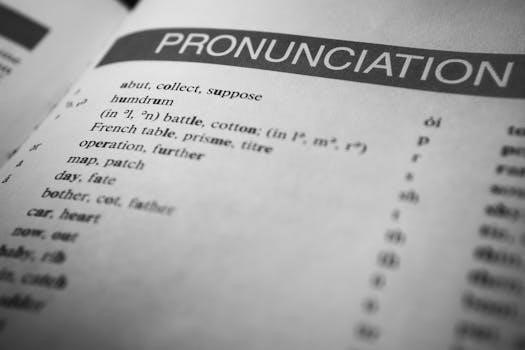Study Guide and Intervention 8 2⁚ Overview
This section provides an overview of the Study Guide and Intervention workbook, designed to aid students in mastering key algebraic concepts. It emphasizes the workbook’s role alongside textbooks and notes for effective learning. It serves as a review tool for quizzes and tests.
Purpose of the Study Guide and Intervention Workbook
The primary purpose of the Study Guide and Intervention Workbook is to provide students with a structured resource for reinforcing and practicing the algebraic concepts covered in Chapter 8. This workbook is designed to be used in conjunction with the main textbook, daily homework assignments, and class notes, offering an additional avenue for comprehension and skill development. It acts as a comprehensive review tool, allowing students to consolidate their understanding of key topics through targeted exercises and examples. The workbook’s emphasis is on practical application of the concepts, thereby preparing students for quizzes and tests. It aims to help students struggling with math concepts, ensuring they grasp the material and build a solid foundation. Ultimately, this guide seeks to facilitate better learning outcomes through consistent practice and targeted intervention. The guide offers a clear path to literacy, comprehension, and practical application, making it an invaluable tool for academic success. The structured practice aids in better retention of learned concepts.
Relation to Textbook and Class Notes
The Study Guide and Intervention Workbook is not intended to replace the textbook or class notes but rather to complement them. It serves as an additional resource for students, working in tandem with the primary learning materials. The textbook provides the core theoretical understanding, while class notes offer specific instructions and examples from the instructor. The workbook reinforces this knowledge through practice problems and varied exercises, solidifying comprehension. It bridges the gap between theory and practical application, allowing students to test their understanding of the concepts taught in class and demonstrated in the textbook. The workbook’s structure is designed to align with the textbook’s content, ensuring a smooth transition between resources. It is a tool for active learning, encouraging students to engage with the material and apply it effectively. This integrated approach, combining textbook theory, class notes guidance, and workbook practice, creates a robust learning system. The workbook facilitates better retention of knowledge and skills through active engagement, enhancing overall academic performance.

Key Concepts in Chapter 8
Chapter 8 focuses on crucial algebraic concepts, including factoring perfect square trinomials, factoring differences of squares, and solving quadratic equations of the form ax² + bx + c = 0. These are essential skills for further study.
Factoring Perfect Square Trinomials
This section delves into the specific techniques for factoring perfect square trinomials, which are trinomials that result from squaring a binomial. Recognizing and factoring these trinomials is crucial for simplifying algebraic expressions and solving equations. The patterns involved in perfect square trinomials allow for efficient factoring once identified. The general forms to remember are a² + 2ab + b² = (a + b)² and a² ⎯ 2ab + b² = (a ‒ b)².
Understanding these patterns is key to mastering this factoring skill. The ability to identify a perfect square trinomial and apply these patterns is a valuable asset. This skill is foundational for solving quadratic equations and simplifying complex expressions. The chapter provides examples and practice to reinforce understanding of these concepts. Factoring perfect square trinomials is an important algebraic skill for any math student. The study guide provides extra practice to ensure mastery.
Factoring Differences of Squares
This section focuses on the method for factoring a difference of squares, a special pattern that arises when subtracting two perfect square terms. The core concept is that any expression in the form a² ‒ b² can be factored into (a + b)(a ⎯ b). This method is essential for simplifying algebraic expressions and solving quadratic equations. Recognizing this specific form is key to applying the correct factoring technique. The chapter provides clear examples to illustrate the application of this method. Mastery of this factoring skill is crucial for success in higher level algebra.
This section emphasizes the importance of identifying perfect square terms and applying the formula. Students will learn how to quickly factor expressions by recognizing this specific pattern. This method is frequently used in simplifying rational expressions. The study guide offers additional practice problems to reinforce this technique. Factoring differences of squares is a fundamental skill that forms the basis for many algebraic manipulations.
Solving ax² + bx + c = 0
This section explores the methods for solving quadratic equations in the standard form ax² + bx + c = 0. The primary focus is on factoring these trinomials to find the roots or solutions of the equation. Factoring involves expressing the trinomial as a product of two binomials, which then allows the application of the zero product property to find the solutions. This method is a cornerstone in algebra. Understanding how to factor these expressions is essential for solving a variety of problems. This section offers examples that showcase different factoring techniques for this type of equation.
The study guide offers step-by-step instructions on how to approach these problems. Special emphasis is placed on identifying the coefficients a, b, and c. Students will learn to decompose the middle term, bx, to achieve the correct binomial factors. Practice problems are included to solidify the understanding of solving quadratic equations by factoring. Proficiency in this topic is vital for future math courses.

Specific Sections and Lessons
This section highlights specific lessons within the study guide, focusing on key topics such as special products, using the distributive property, and solving equations of the form ax² + bx + c = 0, providing a detailed look.

Lesson 8-4⁚ Special Products
Lesson 8-4 delves into the concept of special products, focusing on patterns that emerge when multiplying certain types of binomials. A key area of study is the product of a sum and a difference, which follows the pattern (a + b)(a ⎯ b) = a² ‒ b². This lesson emphasizes recognizing and applying these patterns to simplify algebraic expressions and to perform quick calculations. The study guide provides examples and exercises to reinforce the understanding of how to identify and utilize special product patterns. It also explores how these patterns can be used in reverse to factor expressions, a process directly related to the difference of squares. The lesson aims to equip students with skills to identify these patterns and quickly expand or factor these types of expressions. Understanding the underlying algebraic principles will allow to make solving problems faster and will improve overall math skills. This section is crucial for building a strong foundation for further algebraic studies. The lesson also covers perfect square trinomials.

Lesson 8-5⁚ Using the Distributive Property
Lesson 8-5 focuses on utilizing the distributive property to factor algebraic expressions and solve equations. This lesson emphasizes how the distributive property, a(b + c) = ab + ac, can be applied in reverse to factor out the greatest common factor from a polynomial. The study guide provides examples demonstrating how to identify common factors and effectively factor various expressions. This skill is vital for simplifying expressions, solving equations, and understanding other algebraic concepts. Students will learn to apply the distributive property in factoring techniques, and how this is used to solve certain types of equations. Practical exercises included in the study guide help reinforce the concept and its application. It also covers how the distributive property can be used to combine like terms, simplify expressions before factoring, and solve equations by factoring. This section underscores the importance of understanding how the distributive property works in both directions, and reinforces its role in more advanced algebra. Mastering this property is essential for success in higher math courses.
Lesson 8-7⁚ Solving ax² + bx + c = 0
Lesson 8-7 delves into the methods of solving quadratic equations in the form ax² + bx + c = 0. The study guide emphasizes the use of factoring techniques to find the roots of these equations. This section explains that when a quadratic equation is set equal to zero, the solutions correspond to the x-intercepts of the related quadratic function. The lesson guides students through the process of factoring quadratic trinomials, including those where the leading coefficient, ‘a’, is not equal to one. The guide includes examples showcasing how to factor complex trinomials and apply the zero-product property to find the solutions. Students are instructed on how to check their solutions by substituting them back into the original equation. This lesson is crucial for understanding the relationship between factoring and solving equations. The study guide offers ample practice problems to solidify the skills needed for solving quadratic equations. Furthermore, it prepares students for more advanced mathematical concepts which rely on this foundational skill.

Leave a Reply
You must be logged in to post a comment.